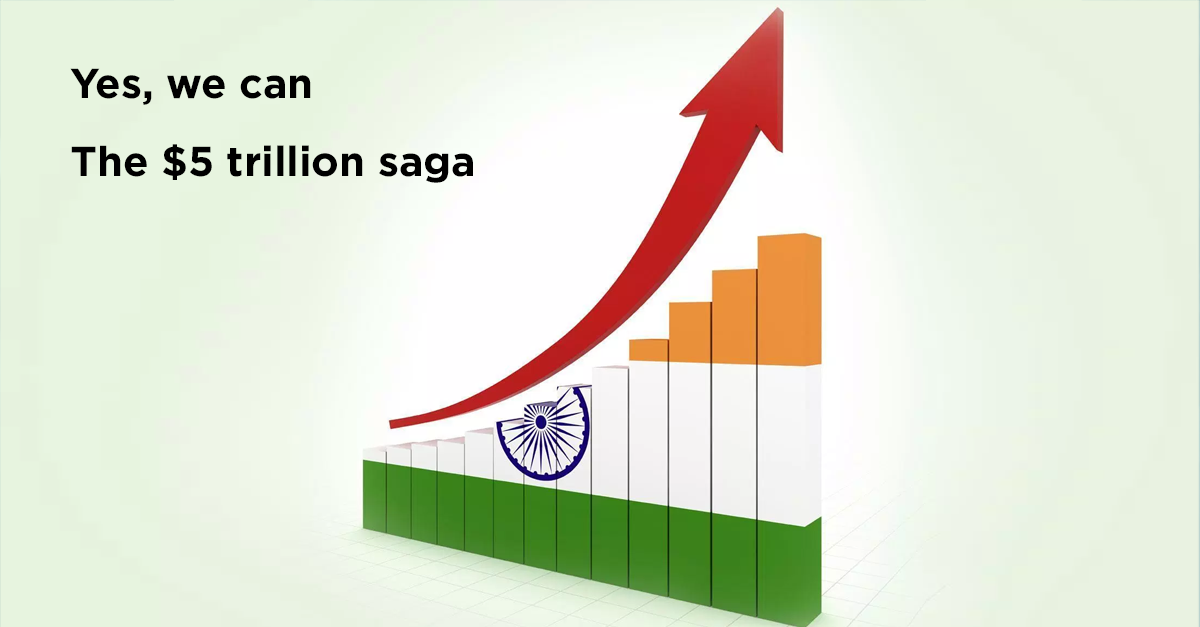“Each tiny effort builds on the next, so that brick by brick, magnificent things can be created.”
– Robin Sharma
I have always believed that in seeking to make a difference, you should always think big. Transformation does not come from moderate thoughts. In her recent Budget speech, India’s Finance Minister Nirmala Sitharaman asserted the government’s goal of becoming a $5 trillion economy by 2025. To put that into context, it took 55 years to breach the trillion-dollar mark, and then in just five years from 2014 to 2019, the economy grew from $1.7 trillion to $2.7 trillion. A laissez-faire economy has its own merits, but a laissez-faire attitude towards it will not help matters. It is true that even with a business-as-usual approach, the Indian economy will continue to grow, but only at around 6% per year in dollar terms. This is greatly underwhelming, considering India’s potential and aspirations. We can and should aim for double-digit growth, which, in my opinion, is highly possible. Let us see how.
The Nudge(t) towards $5 trillion
At a very basic level, GDP is the total of private consumption, investment, government expenditure and exports, minus imports. The 2019 Budget has adopted a ‘nudge’ approach of gently steering the economy towards the desired goal, aiming to lay a roadmap that makes this achievable. Emphasizing on rural development and infrastructure, it checks most of the basics. These are the major allocations:
- 83,000 crore allocated to roads. It will help launch phase 2 of the Bharatmala project, under which state highways will be developed.
- 19,000 crore for the PM Gram Sadak Yojana. Under this 1.25 lakh km of roads will be upgraded.
- 75,000 crore allocated to PM Kisan Samman Nidhi. This scheme provides income support to all land-holding eligible farm families.
- 68,000 crore allocated to Railways, with a special emphasis on Public-Private Partnerships (PPP)
- More than 19 million affordable homes to be built between 2019 and 2022, under the PM Awaas Yojana scheme.
With these allocations and the potential of the Indian economy, we need to make full use of the following opportunities that will help us stride towards the $5 trillion mark:
Focus on SMEs
Mittelstand in Germany, Zhongxiao qi in China – Small and Medium Enterprises are known by different names around the world. In most economies, they play an important role in boosting output. There are three criteria common to their success: clustering, access to finance, and export competitiveness. The good news is that India has been steadily climbing the ‘Ease of Doing Business’ rankings, which will help in creating a more robust manufacturing sector. We already have resourceful and dedicated entrepreneurs in the country. We, however, should continually improve infrastructure, including roads, electricity, airports, ports and telecommunications. Apart from this, the ease of access to finance can be improved further, including access to finance from banks for working capital. Lastly, the global competitiveness of domestically-produced goods needs to be improved. This also brings me to my next point.
Improving low-value exports
Countries like South Korea that went from ‘developing’ to ‘developed’ did so on the back of low-value, low-skill exports such as toys, clothes, shoes, and more. As the country shifts away from its dependence on agriculture, improved global competitiveness of the manufacturing sector will help to fuel growth. Initiatives such as ‘Make in India’ will indeed play a huge role here.
Better skill development
The biggest advantage India has is its favourable demographic. With 700 million people under the age of 35 and a large share of the world’s working-age population, the future looks bright. But, for efficient utilization of this demographic, there needs to be an increased emphasis on qualitatively higher skill development. This includes reading, writing and comprehension skills, which extend beyond the basic literacy markers currently in use. This will help businesses find the right person for the right job and will contribute to reducing unemployment.
Land reforms
As we know, the factors of production include land, labour, capital, and entrepreneurial skill. Among these, land reforms are the need of the hour. There are still issues such as multiple intermediaries between government and cultivators, lack of tenure security, unequal distribution of land and low productivity per hectare. Since the majority of people are still dependent on agriculture, effective land reforms will help the economy. In fact, in western countries, land and buildings are considered capital because land titles are clear. But that is not the case in countries like India. Similar reforms in India will help in clearing up “dead capital” and help people in raising money for small businesses. We also need to improve digitization of land records.
The road ahead
While making use of these opportunities will help us march ahead, we also need to be mindful of the threats. The biggest threat that I see is the global economic slowdown. Since the global recession ten years back, western economies resorted to driving down interest rates and adopting an easy-money policy. But the effects of these policies have started to decrease, leading to a slowdown. This might affect Indian ambitions in the future. Rising oil prices might also adversely affect the growth. But as I have maintained, the Indian economy is robust and resilient enough to withstand these adversities. By 2025, it is likely to emerge as an upper-middle income economy with an affluent middle-class.

